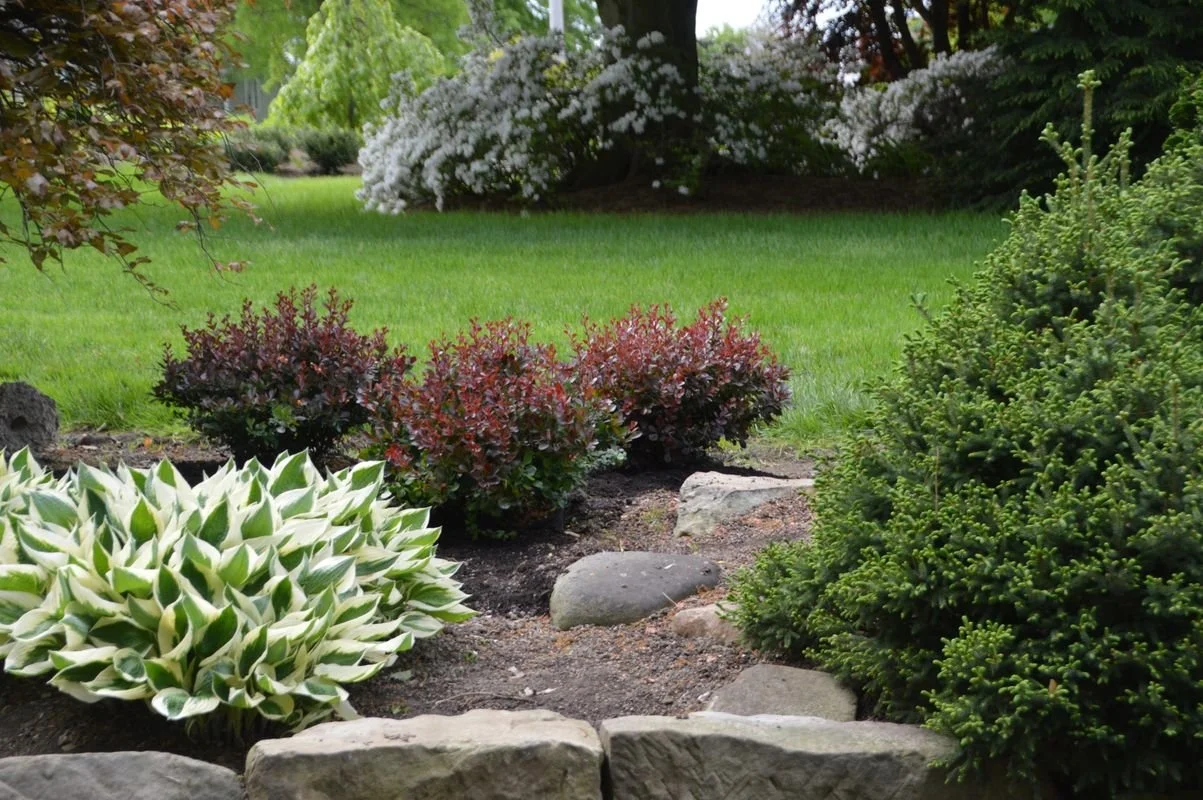The burgundy-foliage varieties of Japanese barberry (Berberis thunbergii) had long been a staple of landscape design in places with heavy deer pressure. The dwarf varieties, in particular, were valuable additions to designs, providing both structure and a beautiful deep burgundy-eggplant color. The perfect foil to Hakenochloa 'All Gold' or dwarf blue spruce.
Until it was recognized as an invasive plant in NYS and its propagation and sale were regulated. And we couldn't plant it in good conscience anymore, anyway, because what landscape designer wants to intentionally introduce an invasive into the environment.
So we limped along, using burgundy-leafed Heuchera varieties or dwarf burgundy-leafed forms of Weigela or maybe burgundy-leafed cultivars of sedum as substitutes, realizing that they didn't really serve the same function in the design as crimson barberry had.
Sigh.
But now, there's a NON-INVASIVE BARBERRY!
WorryFree® Crimson Cutie® Barberry
Berberis thunbergii 'UCONNBTCP4N' PP30095
It is a product of a planned breeding program conducted in Storrs, Conn. The new barberry plant originated from Berberis thunbergii ‘Crimson Pygmy’ (synonym Berberis thunbergii ‘Atropurpurea Nana’) through the use of the mitotic inhibitor colchicine to create an autotetraploid form of the plant. No paternal plant is involved in the creation of ‘UCONNBTCP4N’. Berberis thunbergii ‘Crimson Pygmy’ is not patented and has been used in the nursery industry since 1942. The development of this cultivar included Federal funding.
An autotetraploid is an individual or strain whose chromosome complement consists of four copies of a single genome due to doubling of an ancestral chromosome complement - in this case induced by a mitotic inhibitor. In an autotetraploid, with every chromosome represented four times, normal chromosome pairing at meiosis can be difficult, and can lead to reduced fertility (though this is not always the case).
From the Plant Patent information:
Publication Date: Feb 1, 2018
Patent Grant number: PP30095
Inventor: Mark Brand (Farmington, CT)
Unique characteristics of the new Barberry plant:
• dense habit growing to 45-60 cm (18 - 24 in) tall by 90-105 cm (36 - 42 in) wide in 10 years
• purple-red spring and summer foliage
• foliage thick and slightly leathery, held on stout stems
• fall foliage color is purple-red-orange
• small yellow and red flowers held in clusters of 3 to 6 flowers, in late April-early May
• fruit is red, ripening in October
• cold hardy in winter to at least −26° C (-15 F)
• seed production is 0.2% that of standard, diploid Berberis thunbergii ‘Crimson Pygmy’, so it is essentially seed sterile
• tested to be resistant to black stem rust by the USDA Cereal Diseases Laboratory in St. Paul, Minn.
Plants of the new Barberry differ primarily from plants of Berberis thunbergii ‘Crimson Pygmy’ in that Berberis thunbergii ‘UCONNBTCP4N’ is essentially sterile, while same age ‘Crimson Pygmy’ plants produce over 8,000 seeds per plant per year. In addition, Berberis thunbergii ‘UCONNBTCP4N’ grows approximately 10% larger than ‘Crimson Pygmy’ and has stouter stems and thicker, more leathery foliage.
This is how the plant is described on the "Worryfree" website:
Crimson Cutie® represents the first in a series of non-invasive Japanese barberries bred and tested by the University of Connecticut. Living up to its WorryFree® collection name, Crimson Cutie® will not produce nuisance seedlings or spread to unwanted areas. Approved for sale in the states of New York and Pennsylvania. This replacement for Crimson Pygmy is excellent as an accent or foundation plant in addition to low hedge and border uses. Definitely not a favorite of deer!

